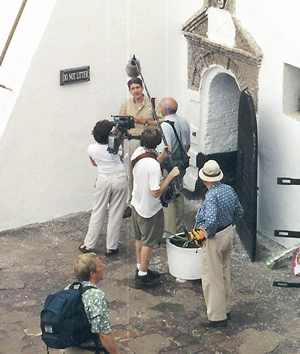Fri 10 Jul, 2009
Obama visits Ghana and Cape Coast Castle
Comments (1) Filed under: History, PoliticsTags: Africa, Barack Obama, Cape Coast Castle, Ghana
 President Barack Obama is arriving today in Accra, the capital of the West African nation of Ghana.
President Barack Obama is arriving today in Accra, the capital of the West African nation of Ghana.
Obama will meet with Ghana’s new president, John Atta Mills, and will deliver a policy address to parliament before leaving after just one day. He has said that he chose Ghana for his African stopover in order to highlight Ghana’s success as a democracy, and his policy speech is expected to focus on the importance of good governance and spending western aid, such as the $20 billion commitment to new food aid which arose of the G-8 summit in Italy, wisely and appropriately.
However, President Obama and his wife, Michelle, are also scheduled to take time during their 24-hour stay to leave Accra on Saturday and visit Cape Coast Castle, the historic slave fort featured in Traces of the Trade.
 Cape Coast Castle was one of more than a hundred European slave-trading posts which dotted the coast of West Africa during the transatlantic slave trade.
Cape Coast Castle was one of more than a hundred European slave-trading posts which dotted the coast of West Africa during the transatlantic slave trade.
This particular fort was established in the 17th century by Swedish traders, and was originally used for trading goods such as timber and gold. Later, it was taken over by the Danes and then the British, and it became a major British slave-trading post. After the slave trade was outlawed, the castle endured and became the headquarters of the colonial government of what was then known as the British Gold Coast.
African traders would bring slaves from hundreds of miles inland to these coastal forts, where they would be kept in unspeakable conditions in dank, cramped underground chambers. European and American slave traders would sail up and down the African coast, stopping at the various forts to barter rum and other trade goods for slaves until they had a full cargo of slaves to transport across the notorious Middle Passage to the Americas.
We filmed at Cape Coast Castle because it was frequently visited by our slave-trading ancestors, the D’Wolf family of Bristol, Rhode Island. My fifth-great grandfather, James D’Wolf, and his brothers purchased more than 10,000 enslaved Africans at trading posts like this.
The scene depicted here shows two of us in an animated discussion about whether James D’Wolf should be seen as particularly evil for his zealous participation in the slave trade, or whether his acceptance of slavery was in fact typical of his entire society. While this moment, like so many of the discussions we had during our journey to Ghana and Cuba, does not appear in the film, there is extensive footage of the ten of us visiting Cape Coast Castle.
Cape Coast Castle is also the subject of a marvelous book by William St. Clair, The Grand Slave Emporium: Cape Coast Castle and the British Slave Trade (Profile Books, 2006).
Troy Nixon says:
Us African American's ancestors had to be a hell of a strong people to endure the hell & horrors of the slave trade-being packed in dungeons like sardines for weeks & then being packed into the bottoms of slave ships like sardines being shackled & chained in anguish & their own waste on voyages that lasted anywhere from 5 to 20 weeks or an average of 80 to 90 days.